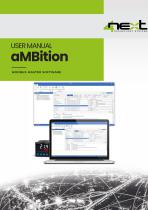 Website:
4neXt
Website:
4neXt
Catalog excerpts

USER MANUAL aMBition MODBUS MASTER SOFTWARE
Open the catalog to page 1
OWNERSHIP AND CONDITIONS The information in this document may be subject to change without notice. Unless otherwise specified, any reference to companies, organizations, products, domain names, e-mail addresses, logos, people, places and events mentioned in this document is purely coincidental. No association with any real company, organization, product, domain name, e-mail address, logo, person, place or event can therefore be inferred from it. Compliance with all applicable copyright laws is the sole responsibility of the user. Due to all rights covered by copyright, no part of this...
Open the catalog to page 2
1. General Description aMBition is an application software that performs functions of ModBus master . The main purpose of the ModBus aMBition software is to read variables from any ModBus slave device and display them on the PC in a readable format. This software has been designed and developed primarily as a utility to help developers and users of ModBus RTU and TCP devices or anyone wishing to use, test and simulate the ModBus protocol. This utility, once registers have been configured, allows you to connect with the slave device (ModBus RTU or ModBus TCP), read the selected registers and...
Open the catalog to page 3
2. Technical Features FREE LICENSE Reading data from ModBus RTU devices PRO LICENSE + Data storage at configurable time intervals on (serial devices) and TCP via Ethernet local database Configuring registers to be read Writing variables Variable configuration (data type, Graphs management Display of the read data in table format Data engineering Workspace management ModBus parameters) Support for char, int, long, float and bits variables Configuration storage in JSON file Importing a JSON file of a previous configuration Readings optimization Display and log on file of data packets in...
Open the catalog to page 4
3.2 Device creation By pressing “New device” button you access the following screen: Fields to be set are: Name: Name of the device or identification (Eg: Flow switch / Energy meter Plant B) Connection: Choose TCP or RTU depending on the type of device (Modbus TCP or Modbus RTU) By choosing SERIAL, you need to set the communication parameters of the serial port: - COM: Which serial Baud rate: Communication speed Data bits: The number of bits per character Parity: The parity - StopBits: The number of stop bits By choosing TCP parameters will be: IP address: IP address of the slave Modbus...
Open the catalog to page 5
Once the device has been created, a new branch will be created in the device tree, SERIAL or TCP. The variables (or TAGs) to be read must then be created for each device. The icons for adding or deleting variables are the following: Add: it allows you to add a new variable Delete: it deletes the selected variable After pressing the "Add" button, the typical parameters of each Modbus TAG must be entered together with parameters for their display. Variable: Variable name and identification label Address: The ModBus address in the Hardware target, the one that the manufacturer declares in the...
Open the catalog to page 6
Function: The Modbus function used for reading. aMBition supports: - 1. Read Coil 2. Read Input 3. Read Holding Registers 4. Read Input Registers Type: The type of data read at that particular register. Boolean data, bits, 8/16/32 and 64 bit integers with and without sign, 32 or 64 bit floats are managed. U.M.: The unit of measurement of the variable (purely descriptive field) Words order: LSW (Least Significant Word) MSW (Most Significant Word) Moltiplier/Divider: Numbers to divide or multiply the read value in order to obtain valid engineering data Offset: Value that is added to the read...
Open the catalog to page 7
3.4 Work window During communication or configuration, the central part of the work window contains: - INSTANT DATA: it displays the salient features of the variable (name, address, reading function, type of data, reading / writing, value, and unit of measurement). HISTORY: Values of the logged variables with relative date and time. DATA LOGGER: This table is visible only when the DESIGN mode is selected and allows you to select which variables will be logged, i.e. stored in the database and the storage interval. Variabile writing To write a variable on the slave, position the cursor on the...
Open the catalog to page 8
3.6 Charts aMBition allows you to create customized chart dashboards. By going to the "Charts" section and pressing the "New" button from the menu bar, a new chart is created. Each chart can display one or more quantities (variables). It is important that before creating the chart, the variable has been set as a "historicized" variable (see DATA LOGGER section).
Open the catalog to page 9
Technology systems YOUR BUSINESS
Open the catalog to page 10All 4neXt catalogs and technical brochures
-
EasyNET quick start
2 Pages
-
EasyNET manual
23 Pages
-
MDB-W manual
12 Pages
-
MDB-W quick start
2 Pages
-
MDB-E quick start
2 Pages
-
MDB-E manual
15 Pages
-
NetLink quick start
2 Pages
-
NetLink manual
15 Pages
-
EasyLog quick start
2 Pages
-
EasyLog manual
24 Pages
-
NetLink
1 Pages
-
aMBition brochure
1 Pages
-
EasyLog XL quick start
2 Pages
-
EasyLog XL manual
24 Pages
-
EasyLog XL brochure
2 Pages
-
I/O Acquisition Modules
1 Pages
-
owa4Xplatform
2 Pages
-
owa450
2 Pages
-
owa3Xplatform
2 Pages
-
zigbee smart building
47 Pages
-
ModBridge
1 Pages
-
MDB-W
1 Pages
-
MDB-E
1 Pages
-
MQTT
2 Pages
-
EasyNET
2 Pages


























